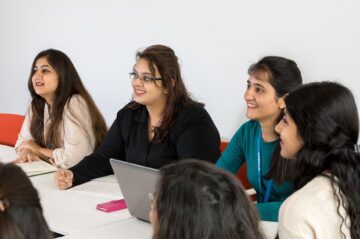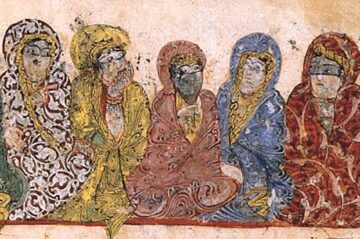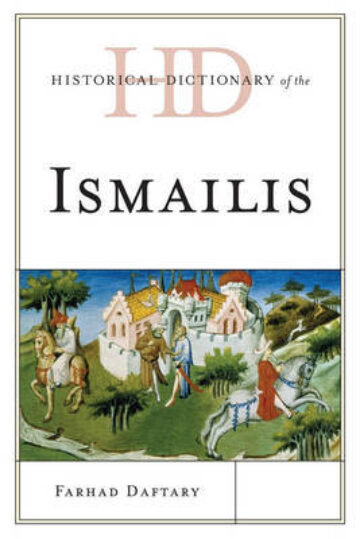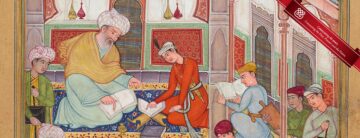Keywords: Pancatantra, Sanskrit, Burzuya, Khusraw Anushirwan, Karirak ud Damanak, Shahnama, Ibn al-Mugaffa‘, Humayun-nama,Iyar-i Danish, Pahlavi, Samarkand.
Abstract: There once lived a lion who terrorized the animals of the jungle by hunting them,until one day they agreed to supply him daily with an animal as long as he stopped his cruelty. The animals continued to cast their lots every day until one day it was the hare’s turn.
The crafty hare arrived late to the hungry and angry lion and explained to him, “I was bringing another hare for your lunch, but on our way here another lion snatched the hare from me, proclaiming that he is the true king of the jungle.” The furious lion wished to confront his adversary, and so he followed the hare to a deep well full of clear water. “Look here, my king!”, said the hare, perched over the well. The lion saw his reflection and, thinking it was the other lion, leaped in and drowned. Thereafter, the animals lived happily ever after.
There once lived a lion who terrorized the animals of the jungle by hunting them, until one day they agreed to supply him daily with an animal as long as he stopped his cruelty. The animals continued to cast their lots every day until one day it was the hare’s turn. The crafty hare arrived late to the hungry and angry lion and explained to him, “I was bringing another hare for your lunch, but on our way here another lion snatched the hare from me, proclaiming that he is the true king of the jungle.” The furious lion wished to confront his adversary, and so he followed the hare to a deep well full of clear water. “Look here, my king!” said the hare, perched over the well. The lion saw his reflection and, thinking it was the other lion, leaped in and drowned. Thereafter, the animals lived happily ever after.
This is just one of the many “nested” stories from the tales of Kalila wa Dimna, adapted and translated into Arabic from the Pahlavi in the eighth century by Ibn al-Mugaffa‘ (d. c. 757 CE). The ultimate source of the Kalila wa Dimna can be traced to an original Sanskrit “Mirror for Princes” that was compiled by an unknown author around 300 CE and entitled the Pancatantra (Five Books or Five Cases of Cleverness). The Sanskrit tales were translated in the sixth century CE into Middle Persian (Pahlavi) by the physician Burzuya (or Burzoy) at the behest of the Sasanian King Khusraw Anushirwan (r. 531-579 CE). In addition to the tales of the Pancatantra, Burzuya incorporated various other stories into his corpus, principally from the Mahabharata epic and other Hindu and Buddhist sources. Burzuya’s Pahlavi title, Karirak ud Damanak, was derived from the names of two jackals, Karataka and Damanaka, the principal characters in the first book of the Pancatantra. Ibn al-Muqaffa‘’s Kalila wa Dimna is therefore an Arabic recension of Burzuya’s now lost Karirak ud Damanak, although the Arab author also inserted a number of additions into his final work.
The earliest surviving manuscripts of the Kalila wa Dimna date from the thirteenth and fourteenth centuries CE, and the widespread popularity of this work is clearly attested to by references to it in other medieval literary works, including the Shahnama of Firdawsi. However, the Kalila wa Dimna was never seen as a fixed corpus of stories, and later authors and editors felt free to add to, subtract from, and otherwise alter its contents. Scholars from the nineteenth century onward have attempted to trace the complex history and origins of the Kalila wa Dimna through both literary and art historical analysis. The tradition of illustrating the tales of the Kalila wa Dimna is probably based on older, well-established traditions of illustrating the animal fables of the Pancatantra. Eighth-century frescoes found at Panjikent, near Samarkand, that include depictions of the Pancatantra tales attest to a well-established iconographic tradition that was later absorbed and adapted in the Muslim Near East.
Ibn al-Mugaffa‘ states in his introduction the four-fold purpose of the Kalila wa Dimna: (1) to engage the youth through the vehicle of animal fables; (2) to delight the hearts of princes through richly illustrated depictions of the tales; (3) to entice kings and common folk everywhere to acquire their own copies and benefit the painters and scribes; and (4) to engage the philosophers in the wisdom of its tales. Were he alive today, Ibn al-Mugaffa‘ would not have been disappointed in the least. Throughout the ages, the Kalila wa Dimna has been reworked and translated, as both prose and poetic verse, into Persian, Mongol, Malay, Ethiopian, Hebrew, Greek, Latin, Spanish, Italian, French, German, and several Slavonic languages. The most famous Persian recension from the Timurid period is the Anvar-i Suhayli, which was later translated into Ottoman rhymed prose as the Humayun-nama for Sultan Suleiman the Magnificent. A new version of the Timurid work entitled Iyar-i Danish was commissioned by the Mughal emperor Akbar.
Further Reading
Atil, Esin. Kalila wa Dimna: Fables from a Fourteenth Century Arabic Manuscript. Washington. DC: Smithsonian Institution Press. 1981
Brockelmann, C. “Kalila wa Dimna” In Encyclopedia of Islam. New Edition, vol. 4, 503-6 Leiden: E.J. Brill.
De Blois, Francois. Burzoy’s Voyage to India and the Origin of the Book of Kalilah wa Dimnah. London: Royal Asiatic Society. 1990.
Grube, Ernst J.. ed. A Mirror for Princes from India: Illustrated Versions of the Kalilah wa Dimnah. Anvar-i Suhayli, Iyar-i Danish and Humayun Nameh. Bombay: Marg Publications, 1991.
O’Kane, Bernard. Early Perisan Painting: Kalila wa Dimna Manusciprts of the Late Fourteenth Century. London and New York. I.B. Tauris, 2003.
Raby, Julian. “The Earliest Illustrations to Kalila wa Dimna.” In A Mirror for Princes from India. ed. Ernst J. Grube. 16-31.
Walzer, Sofie. “An Illustrated Leaf from a Lost Mamluk Kalilah wa Dimnah Manuscript.” Ars Orientalis 2 (1957): 503-5.
Author

Dr Fahmida Suleman
Dr Fahmida Suleman is Phyllis Bishop Curator for the Modern Middle East at the British Museum.







